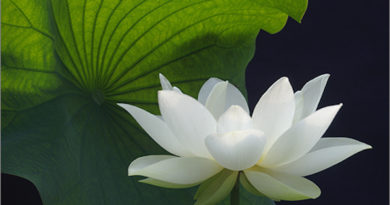FUNDAMENTALS OF VIPASSANA MEDITATION – CHAPTER XII: Impermanence
Realities other than Nibbana – mind and matter – never were in the beginning. They come into being whenever there arise causes. After coming into being they pass away. So we say these realities of mind and matter are impermanent. Take seeing for example. In the beginning there was no seeing. But if the eye is good, the object comes up, there is light, your attention is drawn to it – if these four causes concur, then there is being. Once it has risen, it passes away. No more of it. So we say seeing is impermanent. It is not very easy for an ordinary person to know that seeing is impermanent. Hearing is easier to understand. There was no hearing in the beginning. But if the ear is good, the sound comes up, there is no barrier, your attention is drawn to it – if, these four factors concur, then there is hearing. It arises and then passes away. No more of it. So we say hearing is impermanent.
Now you hear me talking. You hear one sound after another. Once you have heard them, they are gone. Listen, sound, sound, sound. When I say s-, you hear it, then it is no more. When I say – ound, you hear it, then it is gone. That is how they come and pass away. The same is true of other psycho physical phenomena. They come and go. Seeing, hearing, smelling, tasting, touching, thinking, bending, stretching, moving – all come and go away. Because they keep passing away, we say they are impermanent.
Of this, the passing away of consciousness is very clear. If your mind wanders while you are noting rising, falling, you note wandering. As you note it, the wandering mind is no more. It is gone. It has not existed before. It comes about just then. Then it is gone in no time at all when noted. So we say it is impermanent. The passing away of unpleasant feelings, too, is obvious. As you go on noting rising, falling, tiredness, hotness, or pain, appears somewhere in the body. If you concentrate on it and note tiredness, tiredness, etc. sometimes it disappears completely, and sometimes it disappears at least for the time you are noting. So it is impermanent. The meditator realises its impermanent characteristic as he notes its arising and passing away.
This realisation of the fleeting nature of things is Contemplation of impermanence. It comes from your own experience. Mere reflection without personally experiencing it is no true knowledge. Without meditating you will not know what things come up and what things pass away. It is just. book learning. It may be a meritorious deed but not real insight knowledge.
Real insight knowledge is what you know for yourself by meditating on things as they come up and pass away. Here in the audience are lots of meditators who have come to this stage of knowledge. I am not speaking from my own experience alone. No, not even from the experience of forty or fifty disciples of mine. There are hundreds of them. Beginners may not have such clear knowledge yet. It is not quite easy. But it is not too difficult to achieve, either. If you work hard enough as we instruct, you can have it. If you dont, you cant. Educational degrees, distinctions, honours – all are results of hard work. No pain, no gain. The insight knowledge of the Buddha, too, must be worked for.
As your concentration grows sharper, you will be able to see a great number of thoughts in one single act of bending or stretching of the limbs. You will see large numbers of thoughts coming up one after another as you intend to bend or stretch. The same number when you step. There arise a great number of thoughts in the twinkling of an eye. You have to note all these fleeting thoughts as they arise. If you cannot note them, just note aware, aware. You will see that there are four, five, or ten thoughts arising in succession every time you note aware. Sometimes when the awareness is so swift, even the word aware is no longer necessary. Just following them with your intellect will do.
Now a thought rises, now the mind is aware of it; now another thought arises, now the observant consciousness is aware of it. It is like the saying “a morsel of food, a stroke of the stick.” For every thought that arises there is the observant consciousness to be aware of it. Thus aware, these arisings and passings away are made only too plain to you. The wandering mind that arises as you are noting the rising and falling of the abdomen is caught by the observing consciousness as an animal that falls direct into the snare or an object that is hit by a well aimed stone. And once you are aware of it, it is gone. You find it as clearly as if you were holding it in your hand. You find thus whenever consciousness arises.
When tiredness arises, you note tired, and it is gone. It comes up again, you note it again, and it is gone again. This kind of passing away will be made all the more clearer in higher insight. Tired, noted, gone; tired, noted, gone – they pass away one by one. There is no connection between one tiredness and the next. The same with pain. Pained, noted, gone; pained, noted, gone – each pain is gone at each noting. One pain does not mix with the other. Each pain is distinct from the other.
To ordinary people there is no interruption in tiredness or pain. It seems to tire or pain you continuously for a long time. In fact, there is no tiredness or pain for a long while. One tiredness and the next, one pain and the next, just very short pieces, very separate ones. The meditator sees this as he notes.
When you note rising, the rising comes up gradually and passes away by degrees. When you note falling, the falling comes up and passes away by degrees. Common people who are ignorant of this fact think of the rising and falling in terms of the absurd abdominal shape. So from their own experience they think the meditators, too, will only be seeing the absurd abdominal shape. Some make accusations to this effect. Dont speak by guess, please. Try and see for yourselves, let us warn. If you work hard enough, you will find out.
When you note bending, you see clearly how it moves and passes, moves and passes, one move after another. You understand now the scriptural statement that realities like mind and matter do not move from place to place. Ordinary people think it is the same hand that moves, that has been before the bending, and that will be after the bending. They think the same hand moves inwards and outwards. To them it is ever unchanging hand. It is because they have failed to see through the continuity of matter, the way matter rises in succession. It is because they lack in the knowledge to see through. Impermanence is hidden by continuity, it is said. It is hidden because one does not meditate on what arises and passes away. Says Visuddhi Magga.
“Because the rise and fall are not attended to, the characteristic of impermanence does not appear, as long as it is hidden by continuity.”
Visuddhi M. xxi, 781
Since the meditator is watching every arising, all things mental and material appear to him as separate, broken pieces – not as things whole and unbroken. From afar ants look like a line, but nearer you see the ants one by one. The meditator sees things in broken pieces so continuity cannot hide the fact from him. The characteristic of impermanence unfolds itself to him. He is no longer illusioned.
“But when the rise and fall are grasped and continuity is broken, the characteristic of impermanence appears in its true peculiar property.”
Ibid.
This is how you meditate and gain the knowledge of contemplation on impermanence. Mere reflection without meditation will not give rise to this knowledge. Once this knowledge is made become, those on suffering and not self follow.
“To one, Meghiya, who has perceived impermanence the perception of not self is established.” Ang. iii 169
How will you take what you very well know to be capable of rising and passing away to be self, ego, a being? People cling to the self because they think they have been the same person the whole life. Once it is clear to you from your own experience that life is but made up of things that rise and pass away incessantly, you will not cling as self.
Some obstinate persons say that this Sutta is meant for Meghiya alone. This is so something that should not be said. We fear others will come up who will say what the Buddha said were meant for the people of his days, not for us who live today. But he statement is found not in that Sutta alone. In Sambodhi Sutta the Buddha says:
“To one, monks, who has perceived impermanence the perception of not self is established.”
Ang. iii 165
And, if one realises impermanence, one realises suffering, too. The meditator who realises how things are rising and passing away, can see how the two events, rising and passing away, have been oppressing him. The commentary to Sambodhi Sutta says:
“When the characteristic of impermanence is seen, the characteristic of not self is seen, too, since when one of the three characteristics is seen the other two are seen too.”
So, it is very important to understand the one characteristic of impermanence.







